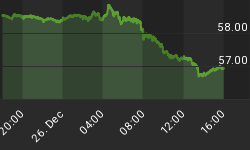Joseph Stiglitz is a Columbia University Professor and a Nobel Prize-winning economist. He extolled the wisdom of Keynesianism on Bloomberg yesterday (video):
"Just think about it. Right now the government can borrow at zero to...two and half percent. And there are so many investments yielding returns of 10, 15, 20% - if you don't make these investments you are really robbing your children."
To those that believe in fairy tales the above logic makes sense. After all, all the U.S. government needs to do is activate your basic carry trade and things will be wonderful. As for threat that the U.S.'s rising debt load will have a Bonnie and Clyde effect on 'the children', think instead of Santa Claus!
Unfortunately, and after blathering on about "we need more automatic stabilizers" and "keep schools/hospitals running", Stiglitz failed to offer a single idea on any of the 'many investments yielding' 20%.
"...we [the U.S. Government] have a backlog of high return investment projects - infrastructure, technology, education."
Of course, what Stiglitz is talking about is not 'returns' as you and I interpret them, but rather the money that would be collected in taxes after the government borrows and puts money to work in the economy. To quote Stiglitz, "for every dollar increase in the economy the tax revenues go up about 20 cents". Assuming a dollar in new debt can create a dollar increase in the economy (it can't*, but let's assume for a moment), this sounds pretty good, doesn't it?
The problem with borrowing a dollar to get back 20 cents is that an additional dollar (or close to a dollar) will need to be borrowed to complete the same feat the next year. If you extrapolate this trend for a decade what you are left with is total debt that is more than 1,000% higher the original dollar borrowed and annualized 'returns' running below the current 10-year Treasury rate (assuming $1 borrowed at 2.5% interest and 20 cents 'returned' each year).
In other words, it is essential to remember that borrowing money to generate tax revenue (or say pay a dividend) is a return of capital, not a return on investment. The difference being that while an investment eventually/hopefully throws off its own cash flow, the return of capital scheme requires more debt creation to keep the payouts going.
* What Stiglitz conveniently neglects to mention is that borrowing a dollar in the U.S. does not translate into a dollar increase to GDP. Rather, and as I am sure Mr. Stiglitz is well aware, the returns the U.S. has been able to squeeze out of every new dollar in debt have been on the decline for decades (Annaly - Debt Saturation). With this in mind, the above math may be closer to borrow $3 to generate $1 in GDP and then collect 20 cents in taxes. Using this math the return of capital to the government would be an attractive 6.67% in the first year, but would dip below the 10-year yield (2.33%) by year number three. Not many investments can produce solid/predictable returns inside of a 3-year period, let alone government spending on construction workers, teachers, nurses, etc. (can the U.S. government effectively invest money in 'technology'?)
In short, there is nothing necessarily right or wrong with claiming the U.S. should go into greater hock because the economy is on the verge of collapse. As per Keynes, perhaps there comes a point when the economy would be better off if people were paid to dig ditches and fill them in again? Nevertheless, there is something intellectually suspect with the contention that low interest rates and debt creation can coalesce to generate spectacular 'returns' given that any rational look at U.S. history claims otherwise.
















